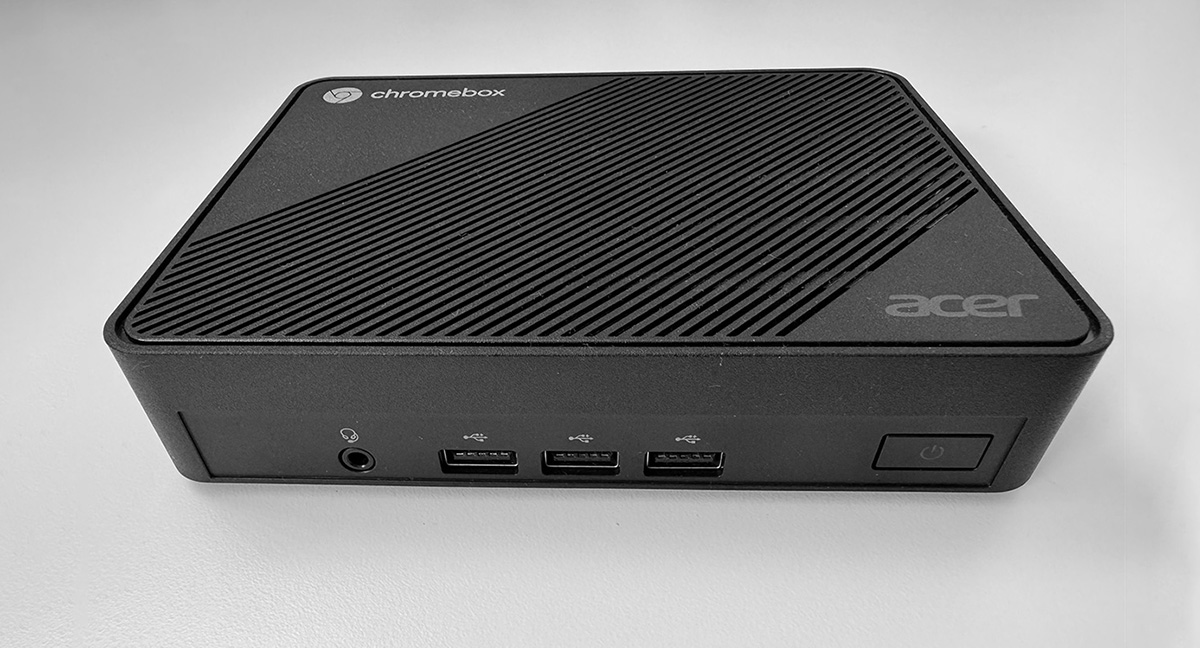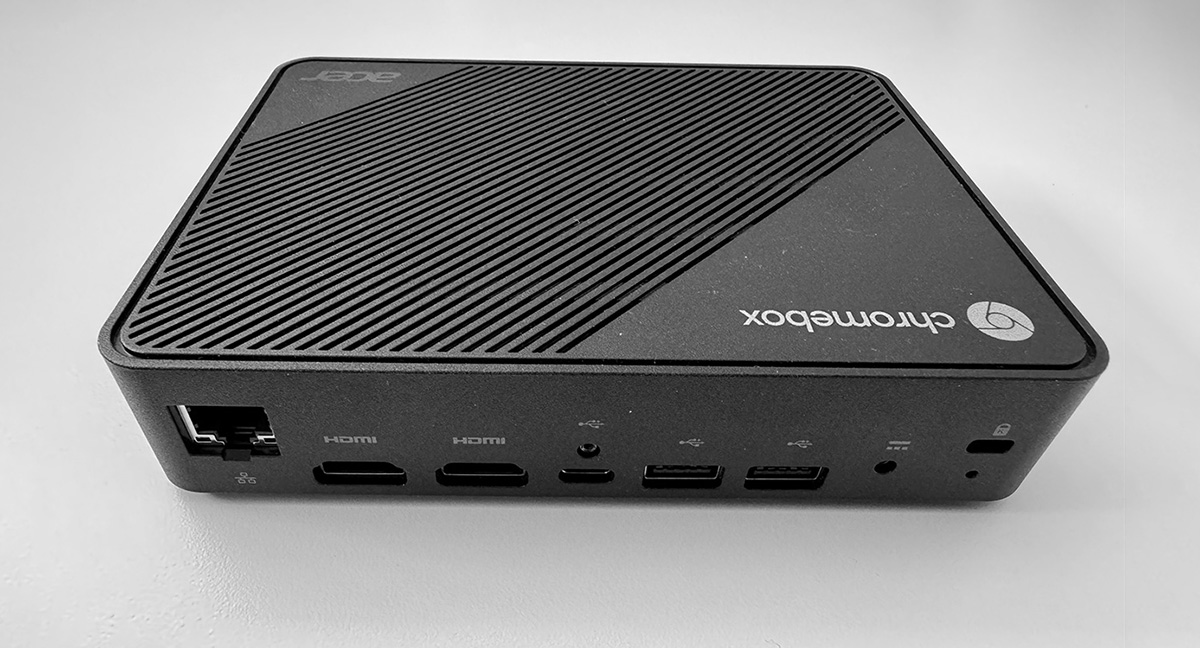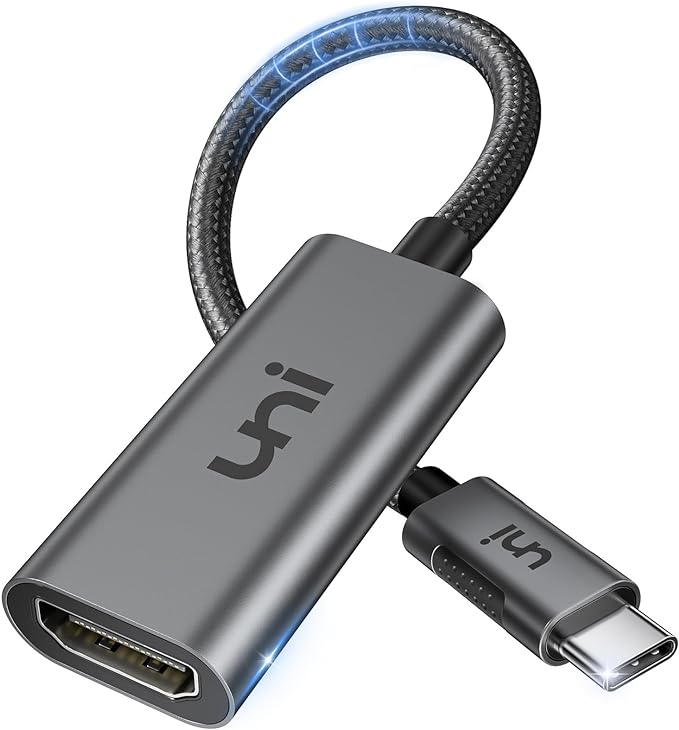Acer recently released an entirely new Chromebox: the Acer Chromebox 2. We were allowed to test it and in this article we describe our experiences.
Introduction
ChromeOS has long been our favourite operating system for digital signage. This started at the time of the affordable Asus Chromebit, which -despite its small size and limited processor- displayed our web-based content perfectly. When the Chromebit was phased out, the more powerful Chromeboxes took its place.
Why ChromeOS?
ChromeOS is ideal for digital signage because of its dedicated kiosk mode. It automatically starts up a device with just one app, after which nothing else can be done with the device. System updates are always performed in the background without the risk of annoying pop-ups. This is sometimes different with other operating systems, such as Windows.
Installation is also remarkably simple. When you buy a ChromeOS kiosk licence, you get login details that allow you to register a new Chromebox directly. The preconfigured kiosk app (in our case, the Bizplay app) is then automatically installed and launched. And that was that. It really couldn't be simpler.
In further use, you can log in to the Google admin environment, where you can find and manage all registered Chromeboxes. However, it's not free: and ChromeOS kiosk licence costs around $27.50/device/year.
Affordable Chromeboxes
For 95% of applications, entry-level Chromeboxes with an Intel Celeron processor have always been perfect. It's just that these have been harder to come by over the past year and a half. Fortunately, that has now changed, including with the arrival of the Acer Chromebox 2, which costs approximately $250 (excl. VAT) for the model with 4GB RAM. We ourselves have recently been testing with the model with 8GB RAM and we are happy to share our findings.
Specifications
At 16 x 12 x 3.4cm, the Chromebox 2 has a nice size that tucks well away behind a monitor. It has an Intel Celeron N4500 processor, Ethernet, WiFi 6, 2x HDMI 1.4b ports and 1x USB-C with DisplayPort support and finally some USB 3.2 ports and an audio jack. It can come with different memory and storage capacities.


4K display limitation
So far, the Chromebox 2 seems like an ideal digital signage player. However... observant readers will have noticed above that the two HDMI ports only support HDMI 1.4b. That means these can only drive 4K at 30Hz. That's fine for static content. But with animations, this is quite a bit more problematic. Especially if you want to show consistently smooth animation like a horizontal news ticker. The difference between 30Hz and 60Hz is then really dramatic: at 30Hz, such a news ticker is very unpleasant to read.
But the good news is that via the USB-C port, 4K at 60Hz is possible. Unfortunately, almost all professional displays have HDMI inputs and no USB-C input. And so the most logical way to connect this Chromebox is still simply with an HDMI cable, after which you're looking at 4K@30Hz.
The solution
Fortunately, there is workaround for the above problem. By using a USB-C to HDMI 2.0 adapter, it is actually possible to get 4K at 60Hz with an HDMI cable. We used a relatively inexpensive adapter from UNI for this purpose.

An alternative is a full USB-C to HDMI 2.0 cable, but during our tests with this, ChromeOS still occasionally struggled to determine that it should run at 60Hz instead of 30Hz.
We also tried a USB-C to HDMI 2.1 cable. In theory, even higher refresh rates can then be achieved, but when tested on a high refresh rate screen, interference occurred in the display. So such a cable is best avoided.
Overall performance
Once running at 4K@60Hz, the Chromebox 2 works like a charm. All content displays razor-sharp. Videos plays smoothly and even a news ticker runs smoothly. If you have a lot of animations at once, page transitions can still be slightly jerky, but that is inherent to the fact that we are dealing with a model with a basic Intel Celeron processor running at 4K. If you want to be guaranteed the smoothest playback in all conditions, you will always have to look at a model with a more powerful processor.
Conclusion
The Acer Chromebox 2 is an excellent newcomer to the Chromebox range. For optimal performance, it is advisable to choose the video connection carefully. With the right setup, this Chromebox delivers excellent performance at a competitive price. Therefore, we highly recommend it.

